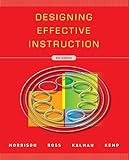Designing effective instruction / Gary R. Morrison ... [et al.].
Publication details: Hoboken, NJ : John Wiley & Sons, c2011.Edition: 6th editionDescription: xxvi, 491 p. : ill. ; 24 cmISBN:- 9780470522820 (pbk.)
- 0470522828 (pbk.)
- 371.3 22 DES.
| Item type | Current library | Call number | Copy number | Status | Date due | Barcode |
|---|---|---|---|---|---|---|
 Book Closed Access
Book Closed Access
|
Engineering Library | 371.3 DES. 1 (Browse shelf(Opens below)) | Available | BUML23070538 | ||
 Book Open Access
Book Open Access
|
Engineering Library | 371.3 DES. 1 (Browse shelf(Opens below)) | 1 | Available | 0011556 |
Table of content
Chapter one: Introduction to the instructional design process
Getting started
Questions to consider
Why instructional design?
What is instructional design?
etc.
Chapter Two: Identifying the need for instruction
Getting started
Questions to consider
Is instruction the answer?
Needs assessment
Goals analysis
etc.
Chapter Three: Learner and contextual analysis
Getting started
Questions to consider
Types of learner characteristics
Contextual analysis
etc.
Chapter Four: Task analysis
Getting started
Questions to consider
Task analysis
Topic analysis
Procedural analysis
etc.
Chapter Five: Instructional objectives
Getting started
Questions to consider
Function objectives
Three objective domains
Developing instructional o0bjectives
etc.
Chapter Six: Designing the instruction: Sequencing
Getting started
Questions to consider
The poner and strike sequencing schemes
Elaboration theory sequencing
From objectives to sequencing
etc.
Chapter Seven: Designing the instruction: Strategies
Getting started
Questions to consider
Why instruction strategies?
Prescriptions for instructional strategies
etc.
Chapter Eight: Designing the instructional message
Getting started
Questions to consider
Preinstructional strategies
Message design for text
etc.
Chapter Nine: Developing instructional materials
Getting started
Questions to consider
Starting the development of the instruction
Heuristics for developing instruction
Putting pen to paper or fingers to keyboard
etc.
Chapter Ten: Design considerations for technology based instruction
Getting started
Questions to consider
Individualized computer and web based instruction
Design considerations for individualized computer
etc.
Chapter Eleven: The many faces of evaluation
Getting started
Questions to consider
Purpose of evaluation
Relationship among formative, summative, and confirmative evaluation
Relationship between evaluation and instructional objectives
etc.
Chapter Twelve: Developing evaluation instruments
Getting started
Questions to consider
Testing knowledge
testing skills and behaviour
Attitudes
etc.
Chapter Thirteen: Using evaluation to enhance programs: Conducting formative and summative evaluation
Getting started
Questions to consider
A basic model for formative evaluation
Types of formative evaluation
Stages of formative evaluation
etc.
Chapter Fourteen: Learning theory and instructional theory
Getting started
Questions to consider
Introduction
Learning theory
etc.
Chapter Fifteen: Planning for instructional implementation
Getting started
Questions to consider
Planned change
The CLER model
Planning the implementation with the CLER model
etc.
Chapter Sixteen: Instructional design project management
Getting started
Questions to consider
Project management
Project agreement and proposal preparation
Instructional design shortcuts
etc.
Includes bibliographical references . _ Glossary : p. 473 - 476 . _ Index : p. 477 - 491


There are no comments on this title.